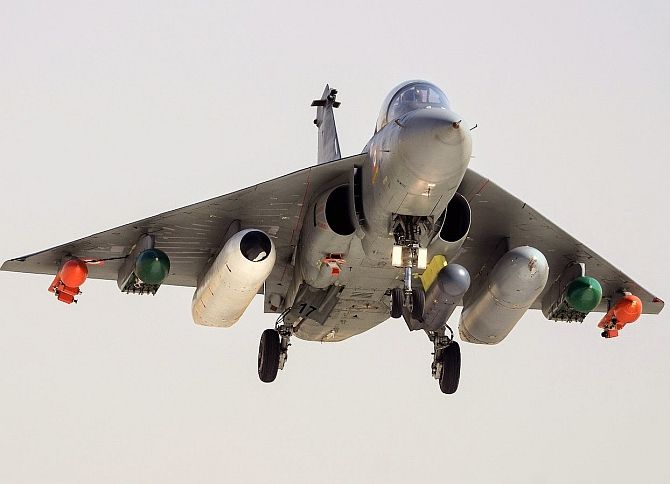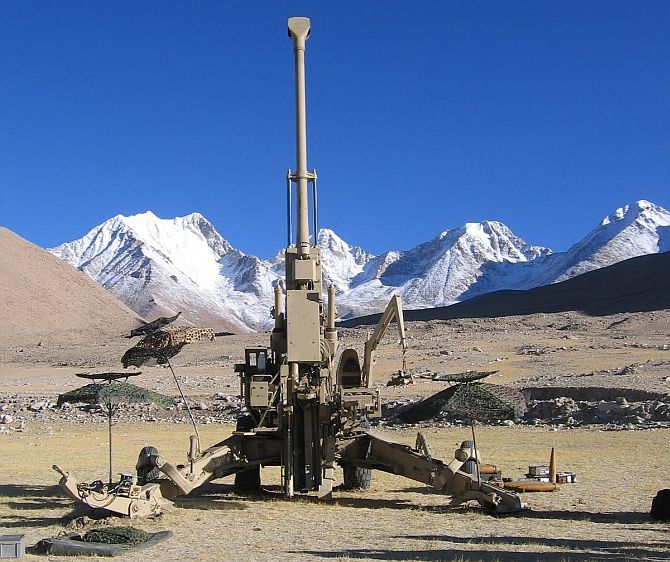
'The government has belied the hope that many harboured of change, efficiency and dismantling old practices as the defence ministry continues to pursue the same well-trodden and wasteful path.'
Rahul Bedi paints a worrying picture as he examines the defence ministry's performance under Narendra Modi's prime ministership.
Recent replies by the ministry of defence to parliamentary questions and parliamentary defence committee reports paint a dismal picture concerning the operational preparedness of the three services.
They remain handicapped by severe equipment shortages, asset duplication, wastefulness and endemic inefficiency of not only the MoD and its vacillation and hidebound procedures, but also of their own internal procedures that have changed little over decades.
All acquisitions, even those for which negotiations have long been concluded, are on hold.
Alongside, the military, defence industry and analysts continue to grapple, with the inexplicable 'Make in India' mantra, that few including Defence Minister Manohar Parrikar comprehend.
Parrikar -- who in military circles is irreverently called Mr Promise-Kar -- admitted as much at Aero-India 2015 in Bengaluru in February.
He declared that a separate policy regarding indigenous material manufacture would be imminently announced alongside a pruned defence procurement procedure that adds yet another incomprehensible bureaucratic layer to the MoD's overloaded procedures.
These revised policies are expected to include revamped guidelines on blacklisting vendors for wrongdoing and for appointing defence agents or lobbyists.
These are eagerly awaited, not only by the services but also domestic and foreign equipment vendors.

As is the services long-standing 'one-rank-one-pension' demand that Modi had promised during his election campaign alongside the even older demand for a war memorial at the India Gate in New Delhi.
Parrikar continues to dole out assurances on resolving both but, for now, that is where it ends.
This, however, is not to argue that India’s defence industrial base does not need augmenting, it badly does.
But it is not one where the financially profligate State-owned entities -- eight defence public sector units and 41 ordnance plants -- are routinely nominated by the MoD to build weapon systems.
Private industry is guardedly optimistic.
"On the regulatory front, the government has taken some steps to ease the procedures for defence manufacturing and enabling partnerships," said Ernst & Young defence analyst Ankur Gupta.
"However, on the procurement side there is still a long waiting list and little has moved forward. In offsets, the story is no better. We really hope that the new DPP committee comes up not with a recycled version but a new policy altogether," he declared.
That is desperately needed.
Meanwhile, inter-service co-operation too remains stillborn and civil-military relations continue to deteriorate.
Compounding matters further is the promotion controversy brewing in the Indian Army that further threatens internal cohesion between its respective arms.
This 'Mandalisation' policy favouring infantry and artillery officers has further exacerbated the situation, after the MoD moved the Supreme Court to settle this row. It opted to do so instead of implementing the recent, and some believe reasoned judgment, of the armed forces tribunal on such skewered promotion procedures.
Such systemic shortcomings are in inverse proportion to the government's braggadocio that all is well on the military capability front and that the MoD is at the top of its game.
Its almost as if the MoD believes in the Latin dictum Cogito ergo sum (I think, therefore I am (militarily capable)).
The myth of the MoD's invincibility and what passes for innovative policy, is reinforced by its first ever, recently released e-book that unabashedly lauds the Modi government's imaginary accomplishments on the military front.
Under 'achievements', the MoD's e-book announces approvals worth Rs 65,000 crore (Rs 650 trillion) for numerous programmes like 384 reconnaissance and surveillance helicopters and six diesel-electric submarines -- the first of which is unlikely to be commissioned before 2025, if all goes well.
Project clearances by the MoD's defence acquisition council -- a procedure known as the acceptance of necessity -- is followed by tenders, trials and price negotiations, which in every instance has taken years to conclude before inking deals.
Add many more years to series-build the equipment or platforms, taking into account the inexperience and expected inefficiencies of local industry, private or State-owned, and there is little room for optimism on the military modernisation front.
The e-book also claims ownership of military modernisation programmes and material imports implemented under the stewardship of A K Antony, decidedly India's most ineffectual and disastrous defence minister and also its longest serving.
These include the induction of the INS Vikramaditya, the second-hand Russian aircraft carrier retrofitted for $2.3 billion (about Rs 14,500 crore/Rs 145 trillion), two indigenously built corvettes and a guided-missile destroyer, US military transporters like the C-130J-30s and C-17s and Russian Mi-17V5 helicopters.
All of these were either executed or acquired by the United Progressive Alliance government.

The e-book also accords credit to the Bharatiya Janata Party-led government for the Tejas light combat aircraft whose final operational clearance has been postponed by almost a year to early 2016, after what it would be almost 34 years of development.
Modi's government has also taken credit for importing airborne early warning and control aircraft and developing the shore-based test facility at Goa that duplicates the landing deck of an aircraft carrier and was inaugurated in early 2014.
It also takes ownership of a host of other programmes that collectively do not constitute an overall boost to India's military capacity, but were implemented by the UPA.
But possibly the most inexplicable move by the NDA government has been the surprise procurement of 36 Dassault Rafale fighters in flyaway condition, announced by Modi in Paris on April 10 for an estimated $8 billion (Rs 50,980 crore/Rs 509.80 trillion).
The cost of each Rafale is pegged at around $180 million (Rs 1,146 crore/Rs 11.46 billion), making it one of the world's most expensive fighter platforms.
The 36 fighter purchase overrides the deal for 126 Rafales, under negotiation since January 2012.
Little is known of the new deal that will add just two combat squadrons to the Indian Air Force's fighter fleet that has depreciated to around 34 squadrons from a sanctioned strength of 45.
Details of maintaining these aircraft and a possible offset obligation, too remains ambiguous.
By 2022, the IAF faces the prospect of its fighter squadrons shrinking to around 22 as older platforms like the MiG-21 and the MiG-27 retire, a recent parliamentary committee has warned.
The committee even highlighted the crisis in the fighter pilot numbers. It revealed that the current fighter aircraft to pilot ratio was 1:0.81, far less than the authorised figure of 1:1.25.
The Pakistan Air Force's fighter to pilot ration is 1:2.5 and that of the People's Liberation Army Air Force, even better.

The operational reality in the two other services, especially the army, is equally if not significantly, more dismal.
The army's war waging capacity is handicapped by equipment paucity, obsolete hardware, restricted night fighting capability and a recurring shortage of 9,642 officers and 24,356 other ranks.
A parliamentary defence committee report tabled in Parliament on April 27 revealed that the army's modernisation was further handicapped by a resource crunch, limited local production of defence equipment and extended delays in procurement.
Its armoured fleet remains largely night blind, its artillery profile comprises ageing Bofors 155mm howitzers and Soviet-era guns with limited ranges and Chetak (Aerospatiale Alouette III) and Cheetah (Aerospatiale SA-315) helicopters inducted into service in the 1960s.
The import of basic infantry weaponry like carbines and assault rifles too remains mired in bureaucratic red tape.
Ironically, the army has been without a carbine after the local manufacture of its World War II Stirling sub-machine gun was discontinued around 2010.
Besides, the army's air defence assets date back to the 1970s, although it has recently inducted the locally-designed Akash surface-to-air missile into service.
Furthermore, the army is reeling under a scandalous shortage of varied ammunition, 186,183 bulletproof jackets, appropriate boots and sturdy backpacks.
Soldiers are known to source the latter items from the open market, as those supplied by the ordnance factory board are of questionable quality.
Even the army's special forces faced an identity crisis, operating without a specialised operational mandate, organisational support or dedicated budget, resulting in piecemeal and incomplete weapon and equipment procurements.
Longstanding proposals to create a special forces command alongside those for space and cyber warfare await MoD clearance.

The navy too is labouring under a shortage of submarines, helicopters, mine counter measure vessels and weapon, missile, radar and sonar systems.
A series of accidents has reduced the number of submarines to 11, some 13 short of the sanctioned number of 24 boats projected by the maritime capacity perspective plan 2012-2027.
Parrikar, however, claims to be fast tracking the long-postponed appointment of a chief of defence staff for greater inter-service 'jointness'.
'In the next two to three months my Cabinet note with the recommendation for a CDS will go to the Cabinet Committee on Security for the final decision,' Parrikar declared on March 13.
'If Integration has to be there, a CDS is a must. I will work it out because the integration of the three forces does not exist in the existing structure,' he declared.
The current arrangement, under which the senior-most of the three service chiefs became the ex-officio chairman chiefs of staff committee till he retired, is unsatisfactory, the minister declared.
The prevailing arrangement did not further tri-service integration, resulting in expensive duplication of assets and inefficiency, he added.
There were also instances when the chairman CoSC held the appointment for a few weeks, having assumed charge shortly before retirement.
Hence, on balance, the new NDA government has belied the hope that many harboured of change, efficiency and dismantling of old practices as the MoD continues to pursue the same well trodden and wasteful path.
"Overall procedural and operational military modernisation does not appear to be a priority for the new government, despite their earlier rhetoric during elections," said military analyst Lieutenant General Vijay Kapur (retd).
It seems to be business as usual, he lamented.










